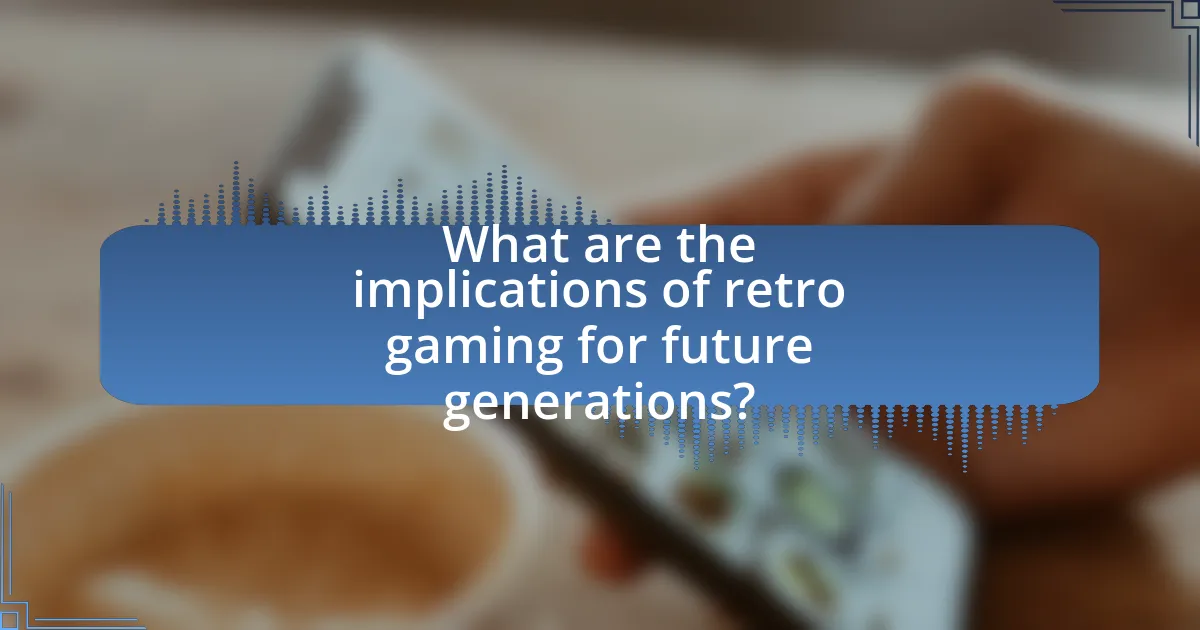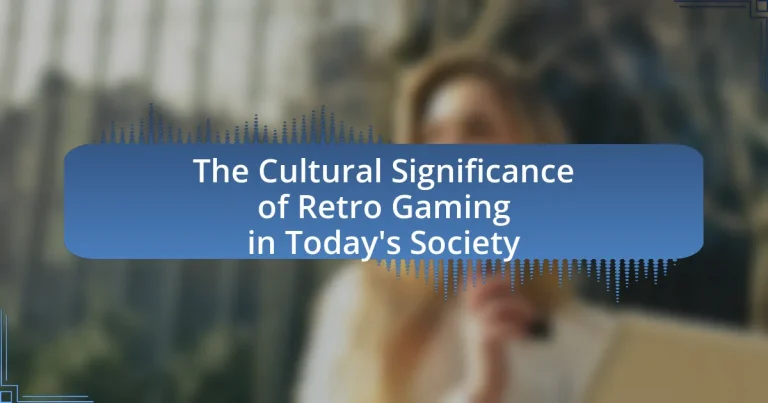The article examines the cultural significance of retro gaming in today’s society, highlighting its role in fostering nostalgia, community, and the preservation of gaming history. It discusses the evolution of retro gaming from its origins in the late 1970s to the present, including key milestones such as the release of iconic consoles and games. The resurgence of interest in retro gaming is attributed to factors like nostalgia, accessibility through digital platforms, and the influence of indie game development. Additionally, the article explores how retro gaming impacts modern gaming culture, community building, and societal values, while also addressing contemporary issues such as diversity and inclusion.
What is the Cultural Significance of Retro Gaming in Today’s Society?
Retro gaming holds significant cultural importance in today’s society as it fosters nostalgia, community, and the preservation of gaming history. This phenomenon is evidenced by the resurgence of interest in classic consoles and games, with sales of retro gaming systems increasing by over 50% in recent years, according to the NPD Group. Additionally, retro gaming events and conventions attract thousands of participants, highlighting the communal aspect of sharing experiences and memories associated with older games. Furthermore, retro gaming serves as a bridge between generations, allowing younger players to engage with the roots of modern gaming, thereby enriching their understanding of the medium’s evolution.
How has retro gaming evolved over the years?
Retro gaming has evolved significantly from its origins in the late 1970s and early 1980s, transitioning from simple pixelated graphics and basic gameplay to a diverse ecosystem that includes remastered classics, indie games inspired by retro aesthetics, and the rise of online communities. Initially, games like Pong and Space Invaders set the foundation for gaming, but advancements in technology led to the introduction of 16-bit consoles, such as the Sega Genesis and Super Nintendo, which offered improved graphics and sound.
In the 1990s, the emergence of 3D graphics and CD-ROM technology transformed gaming experiences, exemplified by titles like Super Mario 64 and Final Fantasy VII. The early 2000s saw the rise of emulation, allowing players to access retro games on modern hardware, while the 2010s introduced a resurgence of interest in retro gaming through mini consoles, such as the NES Classic Edition, and the popularity of indie games that evoke nostalgia.
Today, retro gaming is celebrated through events like conventions and online forums, fostering a community that values both the historical significance and the cultural impact of these games. This evolution reflects a broader trend of nostalgia in entertainment, where retro gaming serves as a bridge between generations, connecting older players with younger audiences.
What key milestones have defined the retro gaming landscape?
Key milestones that have defined the retro gaming landscape include the release of the Atari 2600 in 1977, which popularized home gaming, and the launch of the Nintendo Entertainment System (NES) in 1985, which revitalized the video game industry after the crash of 1983. The introduction of iconic titles such as Super Mario Bros. and The Legend of Zelda established foundational gameplay mechanics and storytelling in gaming. Additionally, the rise of emulation software in the late 1990s allowed players to access classic games on modern hardware, further cementing the cultural significance of retro gaming. The establishment of retro gaming conventions and communities in the 2000s highlighted the nostalgia and appreciation for vintage games, contributing to their enduring popularity.
How have technological advancements influenced retro gaming?
Technological advancements have significantly influenced retro gaming by enhancing accessibility, improving graphics, and enabling the preservation of classic games. The development of emulators allows players to experience retro titles on modern hardware, making them more widely available. For instance, platforms like Steam and GOG have made classic games accessible to new audiences, with GOG reporting over 1,500 retro titles available for purchase. Additionally, advancements in graphics technology have allowed for remastered versions of retro games, such as the “Crash Bandicoot N. Sane Trilogy,” which revitalizes the original experience while attracting both old fans and new players. Furthermore, cloud gaming services have facilitated the play of retro games across various devices, ensuring that these cultural artifacts remain relevant in today’s gaming landscape.
Why is retro gaming experiencing a resurgence?
Retro gaming is experiencing a resurgence due to a combination of nostalgia, accessibility, and the rise of digital platforms that facilitate the preservation and distribution of classic games. Nostalgia plays a significant role, as many adults who grew up in the 1980s and 1990s are now seeking to relive their childhood experiences, leading to increased demand for retro consoles and games. Additionally, platforms like Steam, GOG, and various emulators have made it easier for players to access and enjoy these classic titles, contributing to their popularity. According to a 2021 report by the Entertainment Software Association, 41% of gamers in the U.S. are over the age of 35, indicating a strong market for retro gaming among older demographics. This combination of emotional connection and improved access has solidified retro gaming’s place in contemporary culture.
What factors contribute to the growing popularity of retro games?
The growing popularity of retro games is primarily driven by nostalgia, accessibility, and the rise of indie game development. Nostalgia plays a significant role as many players who grew up in the 1980s and 1990s seek to relive their childhood experiences, leading to a resurgence in interest for classic titles. Accessibility has increased due to the availability of retro games on modern platforms, including consoles, PCs, and mobile devices, allowing a new generation to experience these games. Additionally, the rise of indie game developers has led to a revival of retro aesthetics and gameplay mechanics, further fueling interest in retro gaming. According to a 2021 survey by the Entertainment Software Association, 41% of gamers reported playing retro games, highlighting their enduring appeal and cultural significance in today’s society.
How do nostalgia and emotional connections play a role in this trend?
Nostalgia and emotional connections significantly influence the trend of retro gaming by evoking fond memories and a sense of belonging among players. This emotional resonance is rooted in the shared experiences of individuals who grew up during the peak of classic gaming eras, such as the 1980s and 1990s. Research indicates that nostalgia can enhance mood and foster social connections, as seen in a study published in the journal “Emotion,” which found that nostalgic memories can increase feelings of social connectedness and self-esteem. Consequently, retro gaming serves as a medium for individuals to reconnect with their past, reinforcing community bonds and shared cultural experiences.
What cultural impacts does retro gaming have on society?
Retro gaming significantly influences society by fostering nostalgia, community engagement, and cultural preservation. Nostalgia for retro games often evokes fond memories, creating a shared cultural experience among different generations. This shared experience can strengthen social bonds, as players connect over common interests and memories associated with classic games. Additionally, retro gaming communities, both online and offline, promote collaboration and interaction, enhancing social networks and friendships. Furthermore, retro games serve as cultural artifacts, preserving the history of video gaming and influencing contemporary game design, as seen in the resurgence of pixel art and 8-bit aesthetics in modern titles. This cultural impact is evidenced by the growing popularity of retro gaming events, such as conventions and tournaments, which attract diverse audiences and celebrate the legacy of early video games.
How does retro gaming influence modern gaming culture?
Retro gaming significantly influences modern gaming culture by shaping design aesthetics, gameplay mechanics, and community engagement. Many contemporary games incorporate pixel art and 8-bit soundtracks, reminiscent of classic titles, appealing to nostalgia while attracting new players. For instance, the success of indie games like “Shovel Knight” and “Celeste” demonstrates how retro-inspired design can resonate with audiences, leading to critical acclaim and commercial success. Additionally, retro gaming fosters community through events like retro gaming conventions and online forums, where players share experiences and celebrate classic titles, reinforcing a sense of belonging and shared history within the gaming community.
What role does retro gaming play in community building and social interaction?
Retro gaming plays a significant role in community building and social interaction by fostering connections among players who share nostalgic experiences and interests. This phenomenon is evident in various online forums, social media groups, and local gaming events where individuals bond over classic games, creating a sense of belonging. For instance, studies have shown that retro gaming communities often organize meetups and tournaments, which enhance social ties and encourage collaboration among participants. Additionally, platforms like Twitch and YouTube feature retro gaming content that attracts viewers, further facilitating interaction through comments and live chats, thus reinforcing community dynamics.

How does retro gaming reflect societal values and trends?
Retro gaming reflects societal values and trends by showcasing nostalgia, technological evolution, and cultural shifts. The resurgence of interest in retro games highlights a collective yearning for simpler times, often associated with childhood and community bonding. For instance, the popularity of 8-bit and 16-bit games in the 2020s indicates a desire for authenticity and a reaction against the complexity of modern gaming. Additionally, retro gaming often incorporates themes and aesthetics that mirror the social issues of their time, such as the representation of gender and race, which can be analyzed through games like “Pac-Man” and “Super Mario Bros.” These games not only provide entertainment but also serve as cultural artifacts that reflect the values and norms of the eras in which they were created.
In what ways does retro gaming address contemporary issues?
Retro gaming addresses contemporary issues by fostering community, promoting mental health, and encouraging nostalgia. These games create social connections through online forums and multiplayer experiences, allowing players to bond over shared interests. Research indicates that engaging with retro games can enhance cognitive skills and reduce stress, contributing positively to mental well-being. Additionally, the nostalgia associated with retro gaming can provide comfort during uncertain times, as players reminisce about simpler periods in their lives. This blend of social interaction and emotional support highlights the relevance of retro gaming in addressing modern societal challenges.
How do retro games tackle themes of diversity and inclusion?
Retro games often tackle themes of diversity and inclusion through character representation and narrative choices. For instance, titles like “Street Fighter II” introduced a diverse cast of characters from various cultural backgrounds, allowing players to engage with different identities and experiences. Additionally, games such as “EarthBound” addressed social issues like mental health and acceptance, promoting inclusivity through their storylines and character interactions. These early examples set a precedent for future games, demonstrating that even within the limitations of technology, developers could create meaningful representations that resonate with a wide audience.
What messages about technology and society are conveyed through retro gaming?
Retro gaming conveys messages about nostalgia, technological evolution, and social connectivity. Nostalgia is evident as players often reminisce about their childhood experiences with older games, highlighting the emotional ties that technology can create within society. Technological evolution is showcased through the contrast between retro games and modern gaming, illustrating how advancements have transformed gameplay, graphics, and accessibility. Additionally, retro gaming fosters social connectivity, as it often encourages community engagement through multiplayer experiences and online forums, emphasizing the role of technology in bringing people together. These messages reflect the complex relationship between technology and society, where past innovations continue to influence contemporary interactions and cultural identity.
How does retro gaming intersect with other cultural phenomena?
Retro gaming intersects with other cultural phenomena by serving as a bridge between nostalgia and contemporary digital culture. This intersection is evident in the resurgence of retro-themed merchandise, such as clothing and collectibles, which reflects a broader trend of nostalgia marketing that appeals to both older generations and younger audiences discovering classic games. Additionally, retro gaming influences modern game design, as developers often incorporate pixel art and gameplay mechanics reminiscent of earlier titles, thereby blending past aesthetics with current technology. The popularity of retro gaming events, such as conventions and tournaments, further illustrates this cultural convergence, fostering community engagement and celebrating shared experiences across different age groups.
What connections exist between retro gaming and popular media?
Retro gaming is closely connected to popular media through its influence on film, television, and music, often serving as a source of inspiration and nostalgia. For instance, films like “Ready Player One” and series such as “Stranger Things” prominently feature retro games, showcasing their cultural impact and evoking nostalgia among audiences. Additionally, music artists frequently incorporate retro gaming sounds and themes into their work, further blending the two realms. This connection is evidenced by the resurgence of retro gaming merchandise and references in contemporary media, highlighting its enduring relevance and appeal in today’s society.
How do art and music in retro games influence modern creators?
Art and music in retro games significantly influence modern creators by providing foundational aesthetics and sound design principles that shape contemporary game development. The pixel art style and chiptune music from retro games have inspired modern indie developers to adopt minimalist graphics and nostalgic soundtracks, creating a sense of familiarity and emotional connection for players. For instance, games like “Celeste” and “Undertale” utilize pixel art and 8-bit music to evoke the charm of classic titles while innovating gameplay mechanics. This trend is supported by the success of platforms like Steam, where retro-inspired games often achieve high sales, indicating a strong market demand for this aesthetic. Additionally, the cultural impact of retro games is evident in the revival of 8-bit and 16-bit styles in modern titles, showcasing how past artistic choices continue to resonate with and influence new generations of creators.

What are the implications of retro gaming for future generations?
Retro gaming has significant implications for future generations, primarily by fostering an appreciation for gaming history and influencing modern game design. This appreciation helps younger players understand the evolution of technology and storytelling in games, as evidenced by the resurgence of retro titles and remakes that incorporate classic gameplay mechanics. Furthermore, retro gaming promotes community engagement through shared experiences and nostalgia, which can enhance social connections among players. Studies indicate that nostalgia can improve mood and foster a sense of belonging, suggesting that retro gaming can positively impact mental well-being in future generations.
How can retro gaming be used as an educational tool?
Retro gaming can be used as an educational tool by enhancing cognitive skills, promoting historical awareness, and fostering problem-solving abilities. Engaging with retro games often requires players to develop critical thinking and strategic planning, as many classic games involve complex puzzles and challenges. For instance, studies have shown that playing games like “Tetris” can improve spatial reasoning skills, while games such as “Oregon Trail” provide insights into historical events and decision-making processes faced by pioneers in the 19th century. Additionally, retro gaming can serve as a gateway to discussions about technological advancements and cultural shifts in the gaming industry, making it a multifaceted educational resource.
What skills can players develop through retro gaming experiences?
Players can develop problem-solving skills through retro gaming experiences. Retro games often present challenging puzzles and obstacles that require players to think critically and devise strategies to progress. For instance, classic titles like “The Legend of Zelda” and “Tetris” demand players to analyze situations, make quick decisions, and adapt their approaches based on the game’s mechanics. Research indicates that engaging with such games can enhance cognitive flexibility and improve spatial awareness, as players learn to navigate complex environments and anticipate future challenges.
How can retro gaming foster interest in game design and development?
Retro gaming can foster interest in game design and development by providing accessible examples of fundamental game mechanics and design principles. Classic games often feature straightforward gameplay, which allows aspiring developers to analyze and understand core concepts such as level design, user interface, and storytelling. For instance, games like “Super Mario Bros.” and “Pac-Man” exemplify effective level progression and player feedback, serving as case studies for new designers. Additionally, the retro gaming community encourages modding and fan projects, which offer hands-on experience in game creation, further stimulating interest in the field. This engagement is supported by the resurgence of retro gaming platforms and events, which highlight the enduring appeal and educational value of these classic titles.
What best practices can enhance the appreciation of retro gaming?
To enhance the appreciation of retro gaming, engaging with the historical context and cultural impact of these games is essential. Understanding the evolution of gaming technology and design, as well as the social dynamics of the eras in which these games were popular, fosters a deeper connection to the medium. For instance, recognizing that the original Nintendo Entertainment System revitalized the gaming industry in the 1980s can help players appreciate its significance. Additionally, participating in community events, such as retro gaming conventions or online forums, allows enthusiasts to share experiences and knowledge, further enriching their appreciation. Collecting and preserving original hardware and software also contributes to a tangible connection to gaming history, as evidenced by the increasing value of vintage consoles and games in collector markets.
How can players engage with retro gaming communities effectively?
Players can engage with retro gaming communities effectively by participating in online forums, attending gaming conventions, and joining social media groups dedicated to retro gaming. Engaging in discussions on platforms like Reddit or specialized forums allows players to share experiences, seek advice, and connect with like-minded individuals. Additionally, attending conventions such as the Portland Retro Gaming Expo provides opportunities for face-to-face interactions, networking, and discovering new games. Social media groups on platforms like Facebook or Discord facilitate ongoing conversations and community events, enhancing the sense of belonging among retro gaming enthusiasts. These methods foster a vibrant community where players can exchange knowledge and celebrate their shared passion for retro gaming.
What resources are available for exploring retro gaming history?
Numerous resources are available for exploring retro gaming history, including books, documentaries, online archives, and dedicated websites. Books such as “The Ultimate History of Video Games” by Steven L. Kent provide comprehensive insights into the evolution of gaming from its inception. Documentaries like “High Score” on Netflix delve into the stories behind iconic games and their creators. Online archives, such as the Internet Archive’s Console Living Room, offer access to a vast collection of classic games and their histories. Additionally, websites like RetroGaming.com and forums like AtariAge foster community discussions and share valuable historical information about retro gaming. These resources collectively contribute to a deeper understanding of the cultural significance of retro gaming in today’s society.

